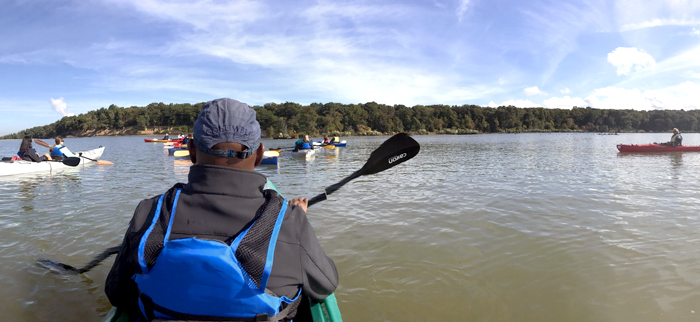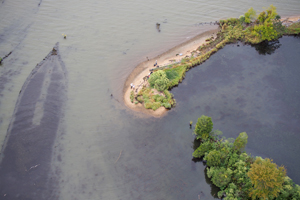The Ghost Fleet of Mallows Bay: The nation’s next National Marine Sanctuary?

Paddlers at Mallows Bay; photo by Stephen Schatz
In Charles County—only an hour drive from the nation’s capital—is a place unlike any other in the country. Emergent at low tide, the withering remains of more than 100 World War I steamships rest in a shallow embayment on the Maryland side of the Potomac River: the Ghost Fleet of Mallows Bay.
Most of these ship hulls have been resting in and around the bay since the late 1920s. In the decades since, nature has taken its course and absorbed the ships into the overall ecosystem, creating a unique ecological setting for bald eagles, osprey, great blue heron, and dozens of recreationally and commercially important fish. Along the shoreline, 12,000-year-old archeological artifacts have been found indicating some of the region’s earliest American Indian cultures. The historical significance of this unique area was enough to warrant its listing on the National Register of Historic Places in 2015 and has placed Mallows Bay in the running to become Maryland’s first national marine sanctuary.

Aerial photo courtesy of Duke University
The ships are coming
In April 1917 when America entered World War I, President Woodrow Wilson called for the building of a thousand ships in 18 months to transport supplies across the Atlantic Ocean. This mobilization by U.S. Shipping Board and Emergency Fleet Corporation quickly made the United States one of the greatest shipbuilding nations in the world. The war, however, ended just over one year later, and many of the ships never embarked on the treacherous journey across the sea.
By war’s end only 290 ships were built, and within a decade nearly all of them were out of operation and abandoned. Between 1922 and 1925, the Western Marine and Salvage Company purchased about 230 vessels and moved them to the Potomac to strip them of engine, boiler, propulsion and other valuables. Composed mostly of wood, the non-valuable remains were burned and moved to Mallows Bay, where many still lie.
Why a sanctuary?
In June 2014, the National Oceanic and Atmospheric Administration—the federal agency with authority to designate an area as a sanctuary—asked the public to generate significant community support and nominate areas for national marine sanctuary status. This was the first time in 20 years that the door was open to protect unique ecological and historical resources by granting them sanctuary status.
Recognizing that these visible pieces of our maritime history were concentrated so close to the nation’s capital, several individuals and community groups partnered with the Maryland Department of Natural Resources, the Maryland Historical Trust, and the Charles County Government to submit a nomination for Mallows Bay.
The Mallows Bay-Potomac River National Marine Sanctuary nomination was submitted in September 2014 and included letters of support from more than 60 community organizations and individuals. Four months later, the administration announced it would add the area to the inventory of eligible nominations, which kick-started a multiyear public process that will determine whether or not to actually designate the area as a sanctuary.

Aerial photo courtesy of Duke University
Status of the designation
In November 2015, the National Oceanic and Atmospheric Administration held public meetings to explain the designation process and ask the public for input on potential boundaries, resources that should be protected, challenges to consider and any other information that should be included in the resource analysis.
Throughout 2016, the department has participated on an inter-governmental committee that has been vigorously analyzing alternatives and preparing draft designation documents, including a draft management plan, draft environmental impact statement, proposed regulations and proposed boundaries for the sanctuary.
Up next is public review of those documents, which is anticipated in 2017. Partners will collect further public input, and the committee will work to incorporate those recommendations before designation occurs. If designated, the federal government, state of Maryland and Charles County will manage the sanctuary jointly.
The original coalition of organizations and individuals at local, state, regional and federal levels that supported the nomination—including elected officials, local businesses, American Indians, museums and universities, as well as environmental, recreation, conservation, fishing, tourism, and education groups—will continue to help mold the vision for the sanctuary and ensure effective protection and management moving forward.
| Enhancing recreation, tourism, education and research
The Department of Natural Resources is dedicated to this effort because of the opportunities to expand public access, enhance recreation and tourism, and promote education and research. The simple act of nominating the area as a sanctuary has ignited immense interest in the area. Charles County elementary and high school groups have begun to use Mallows Bay for immersive field excursions, several trash cleanup events have taken place, there have been an increase in paddlers coming to experience the ships and wildlife, and several universities and organizations have sought partnerships to study the unique ecosystem. For example, in September 2016 researchers from Marine Robotics and Remote Sensing at Duke University used fixed wing drones to collect ultra-high resolution imagery of the ecological and shipwreck features of Mallows Bay. Researchers from Syracuse University and the University of North Carolina Institute of Marine Sciences were also on board to locate submerged aquatic vegetation beds and sample vegetation and sediments. These data will provide a baseline to monitor changes to the area over time. This first-ever in-depth aerial survey of Mallows Bay demonstrates how the national marine sanctuary designation process continues to inspire new research and education partnerships. |
Article by Kimberly Hernandez—coastal planner.
Appears in Vol. 20, No. 1 of the Maryland Natural Resource magazine, winter 2017


 1-888-373-7888
1-888-373-7888 233733
233733